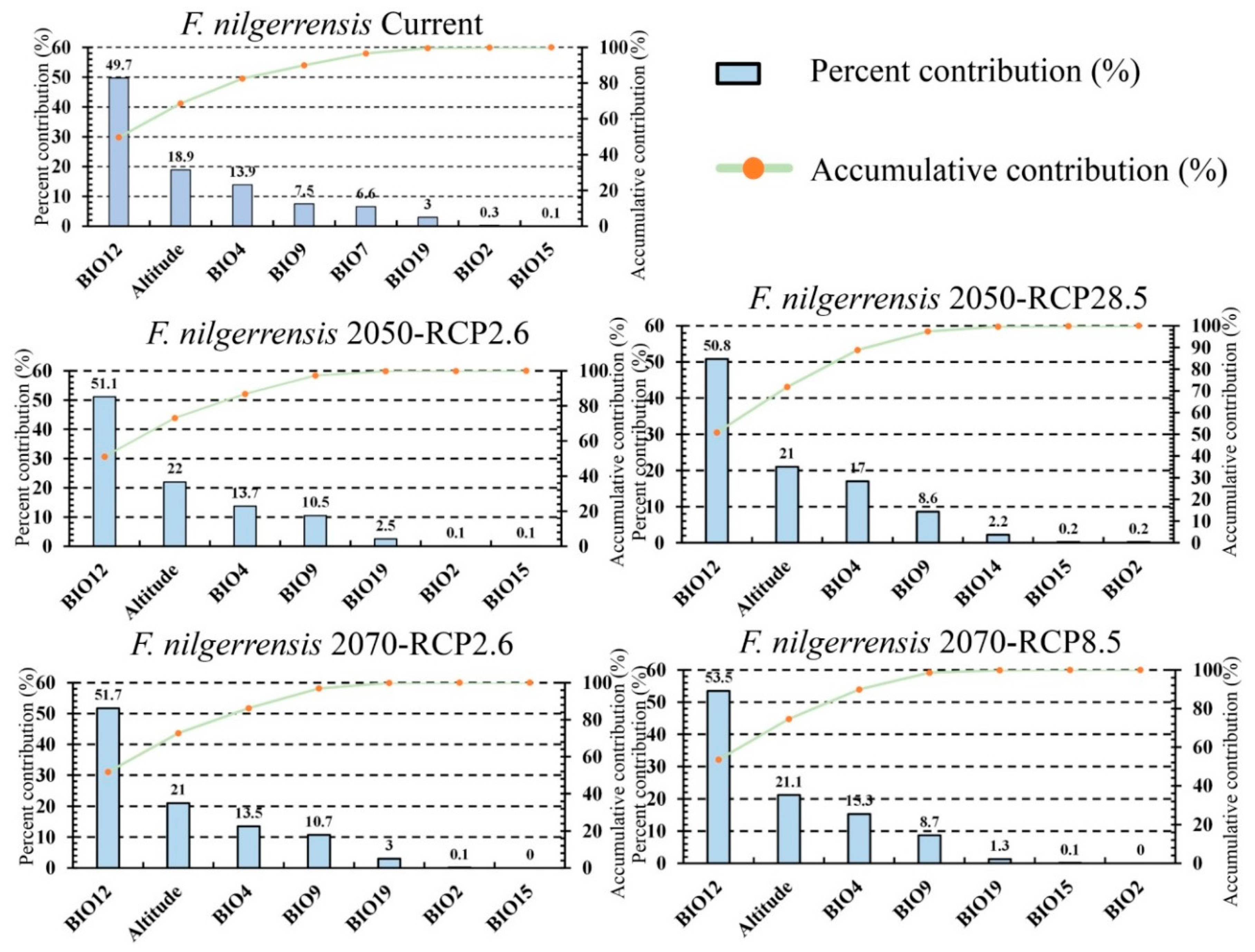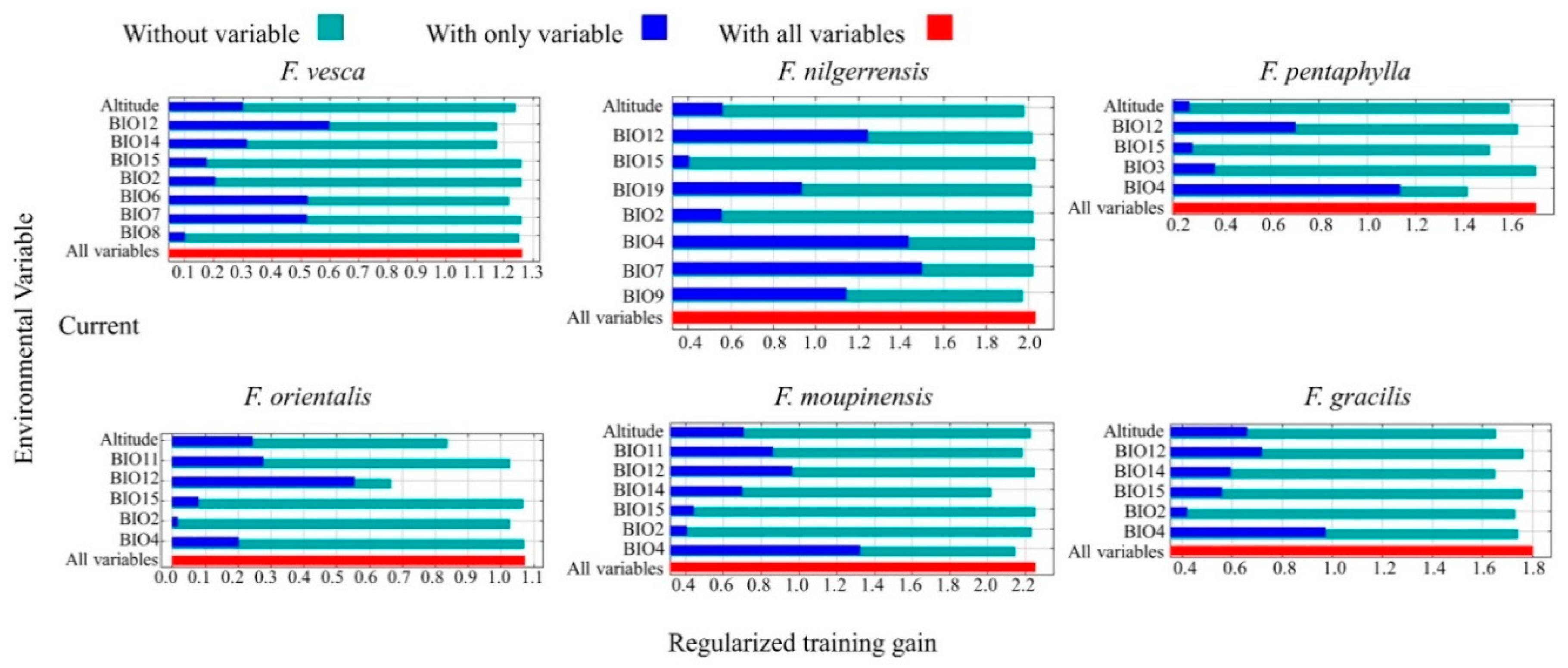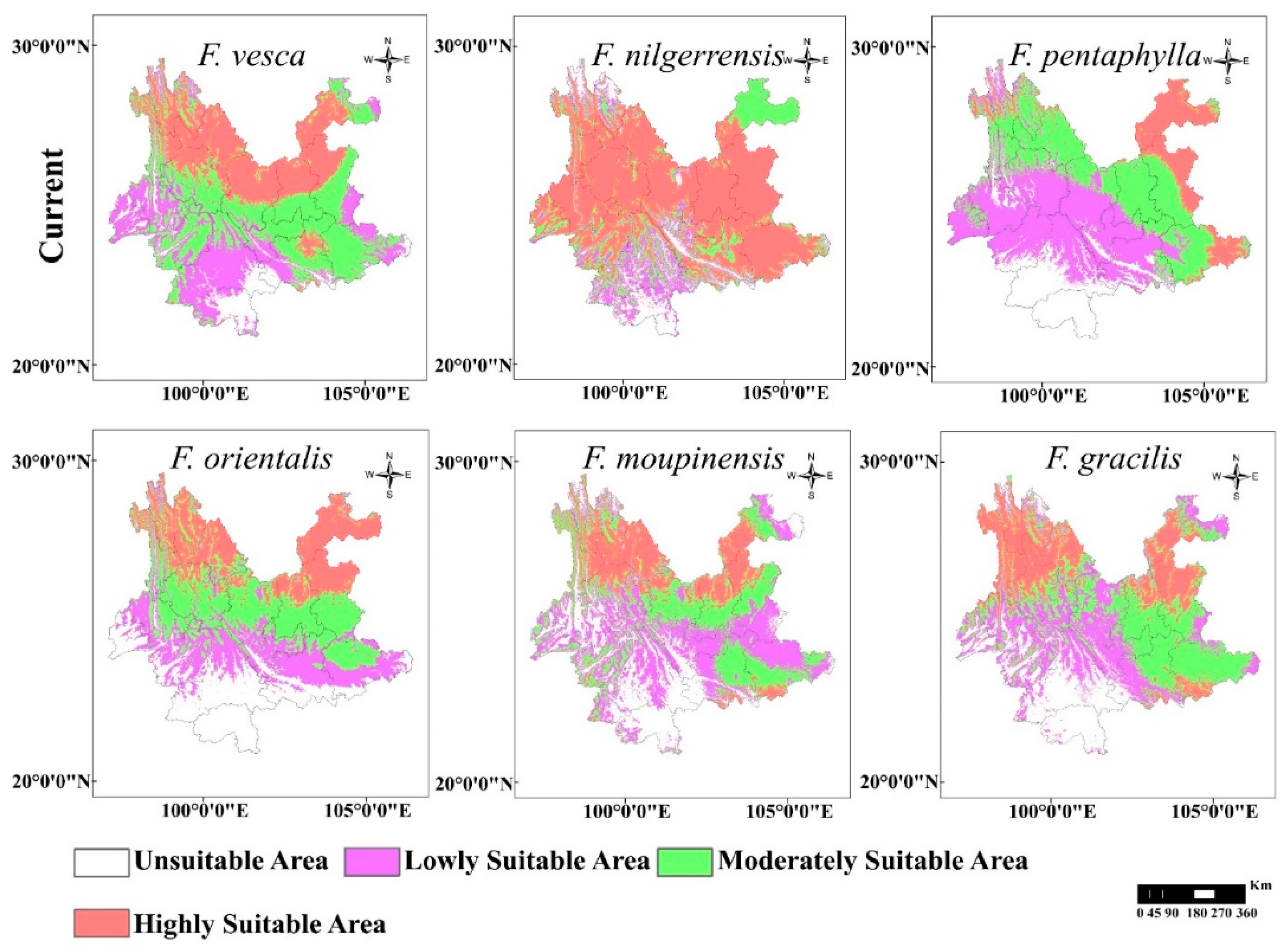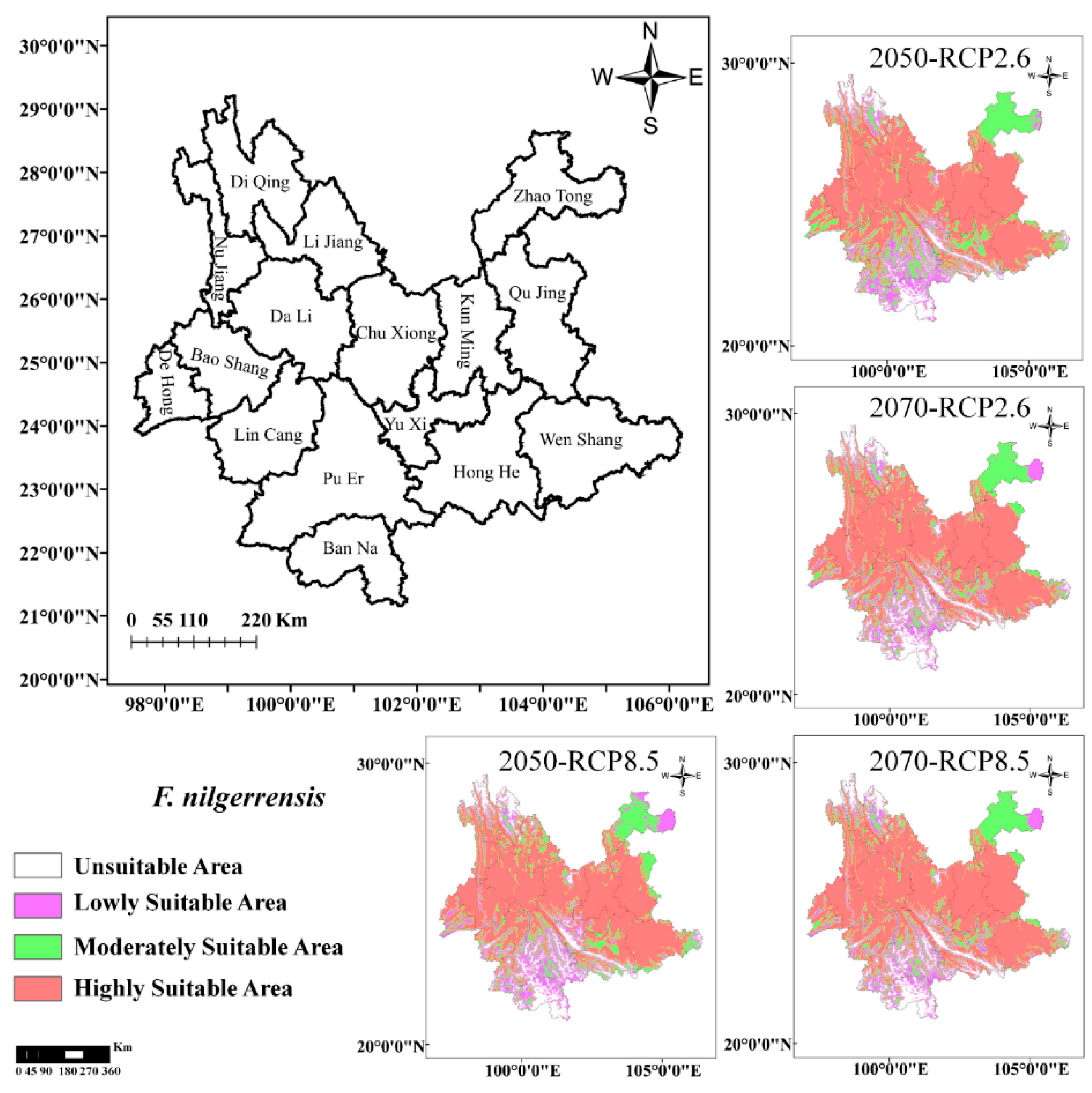Current and Future Potential Distribution of Wild Strawberry Species in the Biodiversity Hotspot of Yunnan Province, China
Abstract
1. Introduction
2. Materials and Methods
2.1. Wild Strawberry Species Data
2.2. Current Environmental Variables
2.3. Future Environmental Variables Data
2.4. Distribution Modeling and Statistical Analysis
3. Results
3.1. Screening of the Environmental Variables under Different Climate Scenarios
3.2. Model Performance and Contributions of the Selected Environmental Variables
3.3. Important Environmental Variables and Their Effects on Chinese Fragaria Distributions
3.4. Potential Distribution in Yunnan Province, China, under Five Climate Scenarios
3.4.1. Current Potential Distribution of Six Wild Strawberry Species
3.4.2. Future Potential Distribution of the Six Wild Strawberry Species
3.5. Shifts in the Centroid of the Total Suitable Areas
4. Discussion
4.1. The Geographical Distribution of Wild Strawberry Species under the Current Scenario
4.2. Effects of Future Climate Change on the Geographical and Dynamic Spatio-Temporal Distribution of Wild Strawberry Species
4.3. Environmental Variables Affecting the Potential Geographical Distribution of Wild Strawberry Species
5. Conclusions
Supplementary Materials
Author Contributions
Funding
Acknowledgments
Conflicts of Interest
References
- Urban, M.C. Accelerating extinction risk from climate change. Science 2015, 348, 571–573. [Google Scholar] [CrossRef] [PubMed]
- Chen, L.; Dong, H.; Peng, H. Diversity and distribution of higher plants in Yunnan, China. Biodivers. Sci. 2013, 21, 359–363. [Google Scholar]
- Li, R.; Sun, H. Phylofloristics: A case study from Yunnan, China. Biodivers. Sci. 2017, 25, 195–203. [Google Scholar] [CrossRef]
- Zhang, M.; Zhou, Z.; Chen, W.; Slik, J.W.F.; Cannon, C.H.; Raes, N. Using species distribution modeling to improve conservation and land use planning of Yunnan, China. Biol. Conserv. 2012, 153, 257–264. [Google Scholar] [CrossRef]
- Li, R.; Qian, L.; Sun, H. Current progress and future prospects in phylofloristics. Plant Divers. 2018, 40, 141–146. [Google Scholar] [CrossRef] [PubMed]
- Li, R.; Kraft, N.J.; Yang, J.; Wang, Y. A phylogenetically informed delineation of floristic regions within a biodiversity hotspot in Yunnan, China. Sci. Rep. 2015, 5, 9396. [Google Scholar] [CrossRef]
- Yi, Y.J.; Cheng, X.; Yang, Z.F.; Zhang, S.H. Maxent modeling for predicting the potential distribution of endangered medicinal plant (H. riparia Lour) in Yunnan, China. Ecol. Eng. 2016, 92, 260–269. [Google Scholar] [CrossRef]
- Stocker, T. Climate Change 2013: The Physical Science Basis: Working Group I Contribution to the Fifth Assessment Report of the Intergovernmental Panel on Climate Change; Cambridge University Press: Cambridge, UK, 2014. [Google Scholar]
- Zomer, R.J.; Xu, J.; Wang, M.; Trabucco, A.; Li, Z. Projected impact of climate change on the effectiveness of the existing protected area network for biodiversity conservation within Yunnan Province, China. Biol. Conserv. 2015, 184, 335–345. [Google Scholar] [CrossRef]
- Boisvert-Marsh, L.; Périé, C.; de Blois, S. Shifting with climate? Evidence for recent changes in tree species distribution at high latitudes. Ecosphere 2014, 5, 1–33. [Google Scholar] [CrossRef]
- Freeman, B.G.; Freeman, A.M.C. Rapid upslope shifts in New Guinean birds illustrate strong distributional responses of tropical montane species to global warming. Proc. Natl. Acad. Sci. USA 2014, 111, 4490–4494. [Google Scholar] [CrossRef]
- Zuckerberg, B.; Woods, A.M.; Porter, W.F. Poleward shifts in breeding bird distributions in New York State. Glob. Chang. Biol. 2009, 15, 1866–1883. [Google Scholar] [CrossRef]
- Thuiller, W.; Lavergne, S.; Roquet, C.; Boulangeat, I.; Lafourcade, B.; Araujo, M.B. Consequences of climate change on the tree of life in Europe. Nature 2011, 470, 531–534. [Google Scholar] [CrossRef] [PubMed]
- Wang, Y.; Ma, J.; Li, X.; Wang, Y.; Cao, S.; Xie, A.; Ye, S.; Dong, B.; Zhao, W.; Qin, Y. The distribution of Athetis lepigone and prediction of its potential distribution based on GARP and MaxEnt. J. Appl. Entomol. 2017, 141, 431–440. [Google Scholar] [CrossRef]
- Zhang, K.; Zhang, Y.; Zhou, C.; Meng, J.; Sun, J.; Zhou, T.; Tao, J. Impact of climate factors on future distributions of Paeonia ostii across China estimated by MaxEnt. Ecol. Inf. 2019, 50, 62–67. [Google Scholar] [CrossRef]
- Zhang, K.; Yao, L.; Meng, J.; Tao, J. Maxent modeling for predicting the potential geographical distribution of two peony species under climate change. Sci. Total Environ. 2018, 634, 1326–1334. [Google Scholar] [CrossRef] [PubMed]
- Phillips, S.J.; Dudík, M.; Elith, J.; Graham, C.H.; Lehmann, A.; Leathwick, J.; Ferrier, S. Sample selection bias and presence only distribution models: Implications for background and pseudo absence data. Ecol. Appl. 2009, 19, 181–197. [Google Scholar] [CrossRef] [PubMed]
- Ward, D.F. Modelling the potential geographic distribution of invasive ant species in New Zealand. Biol. Invasions 2007, 9, 723–735. [Google Scholar] [CrossRef]
- Bebber, D.P.; Ramotowski, M.A.; Gurr, S.J. Crop pests and pathogens move polewards in a warming world. Nat. Clim. Chang. 2013, 3, 985–988. [Google Scholar] [CrossRef]
- Wang, R.; Yang, H.; Luo, W.; Wang, M.; Lu, X.; Huang, T.; Zhao, J.; Li, Q. Predicting the potential distribution of the Asian citrus psyllid, Diaphorina citri (Kuwayama), in China using the MaxEnt model. PeerJ 2019, 7, e7323. [Google Scholar] [CrossRef]
- Hundessa, S.; Li, S.; Li Liu, D.; Guo, J.; Guo, Y.; Zhang, W.; Williams, G. Projecting environmental suitable areas for malaria transmission in China under climate change scenarios. Environ. Res. 2018, 162, 203–210. [Google Scholar] [CrossRef]
- Deng, M.; Lei, J. Chinese Fruit Tree Records Strawberry Rolls; China Forestry Publishing House: Beijing, China, 2005. [Google Scholar]
- Njuguna, W.; Liston, A.; Cronn, R.; Ashman, T.L.; Bassil, N. Insights into phylogeny, sex function and age of Fragaria based on whole chloroplast genome sequencing. Mol. Phylogenet. Evol. 2013, 66, 17–29. [Google Scholar] [CrossRef] [PubMed]
- Lei, J.; Dai, H.; Tan, C.; Deng, M.; Zhao, M.; Qian, Y. Studies on the taxonomy of the strawberry (Fragaria) species distributed in China. Acta Hortic. Sin. 2006, 33, 1–5. [Google Scholar]
- Lei, J.; Zhang, Y.; Zhao, M. Strawberries in China; Liaoning Science and Technology Press: Shenyang, China, 2011. [Google Scholar]
- Lei, J.; Xue, L.; Guo, R.; Dai, H. The Fragaria species native to China and their geographical distribution. In Proceedings of the VIII International Strawberry Symposium, Quebec City, QC, Canada, 15 July 2016; pp. 37–46. [Google Scholar]
- Editorial Board of Flora of China, CAS. Flora of China; Science Press: Beijing, China, 1995. [Google Scholar]
- Kunming Institute of Botany, CAS. Flora of Yunnan; Science Press: Beijing, China, 2006. [Google Scholar]
- Jiang, J. Dictionary of Medicinal Plants; Tianjin Science and Technology Press: Tianjin, China, 2005. [Google Scholar]
- Qiao, Q.; Xue, L.; Wang, Q.; Sun, H.; Zhong, Y.; Huang, J.; Lei, J.; Zhang, T. Comparative transcriptomics of strawberries (Fragaria spp.) provides insights into evolutionary patterns. Front. Plant Sci. 2016, 7, 1839. [Google Scholar] [CrossRef] [PubMed]
- Zhang, M.; Zhou, Z.; Chen, W.; Cannon, C.H.; Raes, N.; Slik, J.F. Major declines of woody plant species ranges under climate change in Yunnan, China. Divers. Distributions 2014, 20, 405–415. [Google Scholar] [CrossRef]
- Wang, R.; Li, Q.; He, S.; Liu, Y.; Wang, M.; Jiang, G. Modeling and mapping the current and future distribution of Pseudomonas syringae pv. actinidiae under climate change in China. PLoS ONE 2018, 13, e0192153. [Google Scholar] [CrossRef]
- Tang, C.Q.; Dong, Y.F.; Herrando-Moraira, S.; Matsui, T.; Ohashi, H.; He, L.Y.; Nakao, K.; Tanaka, N.; Tomita, M.; Li, X.S. Potential effects of climate change on geographic distribution of the Tertiary relict tree species Davidia involucrata in China. Sci. Rep. 2017, 7, 43822. [Google Scholar] [CrossRef]
- Wang, L.; Hu, W.; Magalhaes, R.J.S.; Bi, P.; Ding, F.; Sun, H.; Li, S.; Yin, W.; Wei, L.; Liu, Q. The role of environmental factors in the spatial distribution of Japanese encephalitis in mainland China. Environ. Int. 2014, 73, 1–9. [Google Scholar] [CrossRef]
- Duan, Y.Z.; Yu, H.; Wang, H.T.; Du, Z.Y. Geographical distribution and prediction of potentially suitable regions of endangered relict plant Tetraena mongolica. Plant Sci. J. 2019, 37, 337–347. [Google Scholar]
- Visger, C.J.; Germain-Aubrey, C.C.; Patel, M.; Sessa, E.B.; Soltis, P.S.; Soltis, D.E. Niche divergence between diploid and autotetraploid Tolmiea. Am. J. Bot. 2016, 103, 1396–1406. [Google Scholar] [CrossRef]
- Wan, J.Z.; Chen, L.X.; Gao, S.; Song, Y.B.; Tang, S.L.; Yu, F.H.; Li, J.M.; Dong, M. Ecological niche shift between diploid and tetraploid plants of Fragaria (Rosaceae) in China. S. Afr. J. Bot. 2019, 121, 68–75. [Google Scholar] [CrossRef]
- Wiens, J.J. Climate-Related local extinctions are already widespread among plant and animal species. PLoS. Biol. 2016, 14, e2001104. [Google Scholar] [CrossRef]
- Bellard, C.; Bertelsmeier, C.; Leadley, P.; Thuiller, W.; Courchamp, F. Impacts of climate change on the future of biodiversity. Ecol. Lett. 2012, 15, 365–377. [Google Scholar] [CrossRef]
- Lenoir, J.; Gégout, J.-C.; Marquet, P.; De Ruffray, P.; Brisse, H. A significant upward shift in plant species optimum elevation during the 20th century. Science 2008, 320, 1768–1771. [Google Scholar] [CrossRef]
- Wilson, R.J.; Gutierrez, D.; Gutierrez, J.; Monserrat, V.J. An elevational shift in butterfly species richness and composition accompanying recent climate change. Glob. Chang. Biol. 2007, 13, 1873–1887. [Google Scholar] [CrossRef]
- Li, Z.; Duan, C.; Jin, L.; Hu, X.; Li, B.; Yang, H. Spatial and temporal variability of climatic potential productivity in Yunnan Province, China. Chin. J. Appl. Ecol. 2019, 30, 2181–2190. [Google Scholar]
- Hickling, R.; Roy, D.B.; Hill, J.K.; Fox, R.; Thomas, C.D. The distributions of a wide range of taxonomic groups are expanding polewards. Glob. Chang. Biol. 2006, 12, 450–455. [Google Scholar] [CrossRef]
- Shen, T.; Zhang, J.; Shen, S.; Zhao, Y.; Wang, Y. Distribution simulation of Gentiana rhodantha in Southwest China and assessment of climate change impact. Chin. J. Appl. Ecol. 2017, 28, 2499–2508. [Google Scholar]
- Wei, N.; Cronn, R.; Liston, A.; Ashman, T.L. Functional trait divergence and trait plasticity confer polyploid advantage in heterogeneous environments. New Phytol. 2019, 221, 2286–2297. [Google Scholar] [CrossRef]
- Wood, T.E.; Takebayashi, N.; Barker, M.S.; Mayrose, I.; Greenspoon, P.B.; Rieseberg, L.H. The frequency of polyploid speciation in vascular plants. Proc. Natl. Acad. Sci. USA 2009, 106, 13875–13879. [Google Scholar] [CrossRef]
- Glennon, K.; Ritchie, M.E.; Segraves, K. Evidence for shared broad scale climatic niches of diploid and polyploid plants. Ecol. Lett. 2014, 17, 574–582. [Google Scholar] [CrossRef]
- Theodoridis, S.; Randin, C.; Broennimann, O.; Patsiou, T.; Conti, E. Divergent and narrower climatic niches characterize polyploid species of European primroses in Primula sect. Aleuritia. J. Biogeogr. 2013, 40, 1278–1289. [Google Scholar] [CrossRef]
- Johnson, A.L.; Govindarajulu, R.; Ashman, T.L. Bioclimatic evaluation of geographical range in Fragaria (Rosaceae): Consequences of variation in breeding system, ploidy and species age. Bot. J. Linn. Soc. 2014, 176, 99–114. [Google Scholar] [CrossRef]
- Kirchheimer, B.; Schinkel, C.C.; Dellinger, A.S.; Klatt, S.; Moser, D.; Winkler, M.; Lenoir, J.; Caccianiga, M.; Guisan, A.; Nieto-Lugilde, D. A matter of scale: Apparent niche differentiation of diploid and tetraploid plants may depend on extent and grain of analysis. J. Biogeogr. 2016, 43, 716–726. [Google Scholar] [CrossRef] [PubMed]
- Wiens, J.J. Speciation and ecology revisited: Phylogenetic niche conservatism and the origin of species. Evolution 2004, 58, 193–197. [Google Scholar] [CrossRef] [PubMed]






| Ploidy | Species | Climate Scenario | AUC (10 replicates) | Ploidy | Species | Climate Scenario | AUC (10 Replicates) | ||
|---|---|---|---|---|---|---|---|---|---|
| Mean | Standard Deviation | Mean | Standard Deviation | ||||||
| Diploid (2n = 2x = 14) | F. nilgerrensis | Current | 0.947 | 0.014 | Tetraploid (2n = 4x = 28) | F. orientalis | Current | 0.864 | 0.051 |
| 2050-RCP2.6 | 0.951 | 0.012 | 2050-RCP2.6 | 0.872 | 0.049 | ||||
| 2050-RCP8.5 | 0.95 | 0.014 | 2050-RCP8.5 | 0.858 | 0.055 | ||||
| 2070-RCP2.6 | 0.949 | 0.013 | 2070-RCP2.6 | 0.861 | 0.055 | ||||
| 2070-RCP8.5 | 0.953 | 0.014 | 2070-RCP8.5 | 0.872 | 0.049 | ||||
| F. vesca | Current | 0.845 | 0.033 | F. moupinensis | Current | 0.957 | 0.014 | ||
| 2050-RCP2.6 | 0.872 | 0.072 | 2050-RCP2.6 | 0.956 | 0.019 | ||||
| 2050-RCP8.5 | 0.871 | 0.070 | 2050-RCP8.5 | 0.957 | 0.019 | ||||
| 2070-RCP2.6 | 0.864 | 0.072 | 2070-RCP2.6 | 0.955 | 0.018 | ||||
| 2070-RCP8.5 | 0.857 | 0.078 | 2070-RCP8.5 | 0.954 | 0.016 | ||||
| F. pentaphylla | Current | 0.929 | 0.025 | F. gracilis | Current | 0.928 | 0.032 | ||
| 2050-RCP2.6 | 0.935 | 0.028 | 2050-RCP2.6 | 0.929 | 0.030 | ||||
| 2050-RCP8.5 | 0.915 | 0.026 | 2050-RCP8.5 | 0.931 | 0.032 | ||||
| 2070-RCP2.6 | 0.923 | 0.029 | 2070-RCP2.6 | 0.938 | 0.026 | ||||
| 2070-RCP8.5 | 0.917 | 0.024 | 2070-RCP8.5 | 0.937 | 0.031 | ||||
| Species | Environmental Variables (Unit) | Suitable Range | Optimum Value (Mean ± SD) | |
|---|---|---|---|---|
| Min (Mean ± SD) | Max (Mean ± SD) | |||
| F. nilgerrensis | Temperature Seasonality | 3528.1 ± 66.4 | 5415.9 ± 69.8 | 4437.1 ± 71.2 |
| Temperature Annual Range (°C) | 20.0 ± 0.6 | 26.5 ± 0.2 | 23.3 ± 0.1 | |
| Annual Precipitation (mm) | 934.9 ± 47.6 | 1406.5 ± 56.7 | 1045.3 ± 48.9 | |
| F. vesca | Min Temperature of Coldest Month (°C) | −8.1 ± 1.7 | 6.1 ± 1.8 | −2.3 ± 2.1 |
| Temperature Annual Range (°C) | 16.8 ± 1.1 | 30.7 ± 0.6 | 23.8 ± 0.1 | |
| Annual Precipitation (mm) | 662.2 ± 31.2 | 1361.4 ± 46.4 | 885.0 ± 91.4 | |
| F. pentaphylla | Isothermality | 37.0 ± 1 | -- | 45.5 ± 0.3 |
| Temperature Seasonality | 3767.2 ± 277.7 | 6621.0 ± 100.1 | 5279.6 ± 699.2 | |
| Annual Precipitation (mm) | 750.8 ± 20.3 | 3266.5 ± 865.7 | 914.0 ± 31.2 | |
| F. orientalis | Altitude (m) | 1338.5 ± 21.0 | 4125.0 ± 12.2 | 3469.3 ± 19.4 |
| Mean Temperature of Coldest Quarter (°C) | −5.3 ± 1.7 | 9.0 ± 1.5 | 2.5 ± 1.6 | |
| Annual Precipitation (mm) | 592.9 ± 35.2 | 1178.8 ± 48.9 | 765.9 ± 53.6 | |
| F. moupinensis | Temperature Seasonality | 3426.5 ± 170.7 | 5849.8 ± 51.1 | 4505.6 ± 46.0 |
| Mean Temperature of Coldest Quarter (°C) | 1.9 ± 2.0 | 12.9 ± 2.3 | 7.4 ± 2.1 | |
| Annual Precipitation (mm) | 829.3 ± 33.4 | 1405.1 ± 65.2 | 976.0 ± 41.7 | |
| F. gracilis | Altitude (m) | 1688.7 ± 28.7 | 3719.8 ± 11.4 | 2577.9 ± 274.3 |
| Temperature Seasonality | 3803.0 ± 50.3 | 6014.6 ± 344.5 | 4552.7 ± 70.7 | |
| Annual Precipitation (mm) | 762.6 ± 37.2 | 1624.0 ± 122.1 | 940.3 ± 33.8 | |
| Ploidy | Species | Climate Scenario | Unsuitable Area (× 104 km2) | Lowly Suitable Area (× 104 km2) | Moderately Suitable Area (× 104 km2) | Highly Suitable Area (× 104 km2) | Percentage of Highly Suitable Area in Yunnan Province |
|---|---|---|---|---|---|---|---|
| Diploid (2n = 2x = 14) | F. nilgerrensis | Current | 3.32 | 4.92 | 7.61 | 23.56 | 59.79% |
| 2050-RCP2.6 | 2.64 | 4.70 | 8.33 | 23.72 | 60.21% | ||
| 2050-RCP8.5 | 3.70 | 5.63 | 7.70 | 22.36 | 56.76% | ||
| 2070-RCP2.6 | 3.49 | 4.91 | 7.36 | 23.65 | 60.02% | ||
| 2070-RCP8.5 | 3.08 | 6.78 | 9.92 | 19.62 | 49.80% | ||
| F. vesca | Current | 3.32 | 9.92 | 15.36 | 10.80 | 27.42% | |
| 2050-RCP2.6 | 4.73 | 9.34 | 13.74 | 11.58 | 29.40% | ||
| 2050-RCP8.5 | 6.36 | 7.00 | 12.57 | 13.47 | 34.19% | ||
| 2070-RCP2.6 | 5.07 | 9.42 | 14.55 | 10.36 | 26.30% | ||
| 2070-RCP8.5 | 5.77 | 6.28 | 13.05 | 14.29 | 36.27% | ||
| F. pentaphylla | Current | 6.79 | 14.68 | 12.92 | 5.01 | 12.72% | |
| 2050-RCP2.6 | 5.77 | 16.91 | 12.53 | 4.20 | 10.65% | ||
| 2050-RCP8.5 | 4.18 | 10.26 | 15.58 | 9.38 | 23.81% | ||
| 2070-RCP2.6 | 3.56 | 12.96 | 14.76 | 8.11 | 20.59% | ||
| 2070-RCP8.5 | 5.60 | 13.41 | 13.05 | 7.34 | 18.63% | ||
| Tetraploid (2n = 4x = 28) | F. orientalis | Current | 9.20 | 9.06 | 12.56 | 8.58 | 21.78% |
| 2050-RCP2.6 | 8.86 | 8.80 | 13.72 | 8.02 | 20.35% | ||
| 2050-RCP8.5 | 8.49 | 8.99 | 13.94 | 7.98 | 20.26% | ||
| 2070-RCP2.6 | 7.78 | 8.53 | 12.43 | 10.66 | 27.05% | ||
| 2070-RCP8.5 | 9.89 | 10.48 | 13.52 | 5.51 | 13.98% | ||
| F. moupinensis | Current | 8.48 | 12.33 | 11.41 | 7.19 | 18.24% | |
| 2050-RCP2.6 | 7.62 | 12.46 | 11.20 | 8.12 | 20.60% | ||
| 2050-RCP8.5 | 5.03 | 11.63 | 14.23 | 8.51 | 21.61% | ||
| 2070-RCP2.6 | 4.88 | 14.41 | 11.86 | 8.25 | 20.94% | ||
| 2070-RCP8.5 | 5.48 | 9.69 | 12.95 | 11.29 | 28.65% | ||
| F. gracilis | Current | 7.72 | 10.18 | 12.74 | 8.76 | 22.23% | |
| 2050-RCP2.6 | 7.12 | 10.61 | 13.79 | 7.88 | 20.00% | ||
| 2050-RCP8.5 | 8.18 | 9.99 | 14.59 | 6.64 | 16.86% | ||
| 2070-RCP2.6 | 6.53 | 12.46 | 13.11 | 7.29 | 18.51% | ||
| 2070-RCP8.5 | 8.33 | 13.77 | 12.15 | 5.16 | 13.09% |
© 2020 by the authors. Licensee MDPI, Basel, Switzerland. This article is an open access article distributed under the terms and conditions of the Creative Commons Attribution (CC BY) license (http://creativecommons.org/licenses/by/4.0/).
Share and Cite
Yang, J.; Su, D.; Wei, S.; Chen, S.; Luo, Z.; Shen, X.; Zhang, Z.; Jamil, A.; Tong, J.; Cui, X. Current and Future Potential Distribution of Wild Strawberry Species in the Biodiversity Hotspot of Yunnan Province, China. Agronomy 2020, 10, 959. https://doi.org/10.3390/agronomy10070959
Yang J, Su D, Wei S, Chen S, Luo Z, Shen X, Zhang Z, Jamil A, Tong J, Cui X. Current and Future Potential Distribution of Wild Strawberry Species in the Biodiversity Hotspot of Yunnan Province, China. Agronomy. 2020; 10(7):959. https://doi.org/10.3390/agronomy10070959
Chicago/Turabian StyleYang, Junyu, Daifa Su, Shijie Wei, Shanyan Chen, Zhiwei Luo, Xuemei Shen, Zhenrong Zhang, Arslan Jamil, Jiangyun Tong, and Xiaolong Cui. 2020. "Current and Future Potential Distribution of Wild Strawberry Species in the Biodiversity Hotspot of Yunnan Province, China" Agronomy 10, no. 7: 959. https://doi.org/10.3390/agronomy10070959
APA StyleYang, J., Su, D., Wei, S., Chen, S., Luo, Z., Shen, X., Zhang, Z., Jamil, A., Tong, J., & Cui, X. (2020). Current and Future Potential Distribution of Wild Strawberry Species in the Biodiversity Hotspot of Yunnan Province, China. Agronomy, 10(7), 959. https://doi.org/10.3390/agronomy10070959






